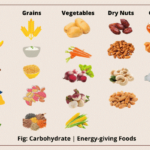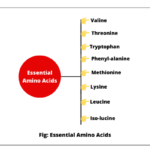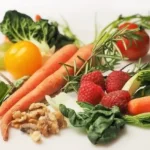30 Carbohydrates MCQ for Your Competitive Exams (2025)
Welcome to this Ultimate Carbohydrates MCQ Quiz! This quiz contains 30 multiple-choice questions based on carbohydrates, which will test knowledge in carbohydrates as well as also enhance your knowledge through explanations provided.
These 30 questions are very important for those who are biology students or preparing for the competitive exams like NEET, SSC CGL, RRB, UPSC, IES, etc. So, are you ready to test your knowledge and score 30/30? Let’s start from the question number 1.
1. What is the general chemical formula of carbohydrates?
A. Cₙ(H₂O)ₙ
B. CₙH₂ₙOₙ
C. CₙH₂ₙ₊₂Oₙ
D. CₙHₙOₙ
a
The general formula for carbohydrates is Cₙ(H₂O)ₙ, where n is an integer, which represents the number of carbon atoms. Most of the carbohydrates contain only three elements: carbon, hydrogen, and oxygen. This general formula follows the ratio of 1 carbon : 2 hydrogen : 1 oxygen, similar to water (H₂O), which is why they are also called hydrates of carbon.
2. Which of the following is the simplest carbohydrate that provides an instant source of energy?
A. Sucrose
B. Glucose
C. Starch
D. Cellulose
b
Glucose (C₆H₁₂O₆) is a simplest form of carbohydrate because it is a monosaccharide easily absorbed by the body. It is quickly absorbed into the bloodstream and utilized by the body cells to produce energy (ATP). That is why it is an instant source of energy for the body, especially during physical or mental activity.
3. Which of the following is formed by only one sugar molecule?
A. Monosaccharides
B. Disaccharides
C. Polysaccharides
D. Oligosaccharides
a
Carbohydrates are classified based on the number of sugar units: Monosaccharides (1 sugar molecule), Disaccharides (2 sugar molecules), and Polysaccharides (many sugar molecules). Monosaccharides are the basic building blocks of carbohydrates.
4. Which of the following is a monosaccharide?
A. Sucrose
B. Lactose
C. Glucose
D. Maltose
c
Glucose, galactose, and fructose are the examples of monosaccharides.
5. Which of the following is the sweetest naturally occurring sugar?
A. Glucose
B. Sucrose
C. Lactose
D. Fructose
d
Fructose is the sweetest of all naturally occurring sugars. It is found in fruits, honey, and some vegetables. It is sweeter than glucose, sucrose, and lactose.
6. What is the main function of carbohydrates in the body?
A. Building muscle
B. Providing energy
C. Producing hormones
D. Storing genetic information
b
The main function of carbohydrates in the body is to provide instant energy. Glucose is used in cellular respiration to produce ATP.
7. Which carbohydrate is also known as milk sugar?
A. Glucose
B. Sucrose
C. Lactose
D. Fructose
c
Lactose is the carbohydrate commonly known as milk sugar. It’s a disaccharide composed of glucose and galactose. Lactose is a natural component of milk, which is especially found in the mammal milk, such as cows, buffalos, humans, and goat.
8. Which of the following is not a disaccharide?
A. Lactose
B. Maltose
C. Sucrose
D. Fructose
a
Fructose is the not a disaccharide. It is a monosaccharide.
9. Sucrose is composed of which two monosaccharides?
A. Glucose + Glucose
B. Glucose + Fructose
C. Galactose + Glucose
D. Fructose + Galactose
b
Sucrose (table sugar) is a disaccharide made of glucose and fructose monosaccharides. Lactose is composed of one glucose and galactose molecule, while maltose (malt sugar) is made up of glucose and glucose.
10. Which disaccharide is commonly found in malted food and drinks?
A. Sucrose
B. Lactose
C. Maltose
D. Cellulose
c
Maltose, also known as malt sugar, is a disaccharide composed of two glucose molecules linked together by a α-1,4 glycosidic bond. It is mainly found in malted products.
11. What type of bond joins the two monosaccharides in a disaccharide?
A. Peptide bond
B. Glycosidic bond
C. Hydrogen bond
D. Ionic bond
b
Monosaccharides are joined by glycosidic bonds to form disaccharides and polysaccharides.
12. Which of the following is a food storage polysaccharide found in plants?
A. Glycogen
B. Maltose
C. Cellulose
D. Starch
d
Starch is the main food storage polysaccharide commonly found in plants for storing food energy.
13. Which of the following is a food storage polysaccharide found in animals?
A. Cellulose
B. Starch
C. Glycogen
D. Chitin
c
Glycogen is the main food storage polysaccharide commonly found in animals. It is mainly stored in the liver and muscles.
14. Cellulose is an example of which type of carbohydrate?
A. Monosaccharide
B. Disaccharide
C. Oligosaccharide
D. Polysaccharide
d
Cellulose is a complex structural polysaccharide formed of numerous mono sugars interlinked by glycosidic bonds. It is found in plant cell walls. Other example of polysaccharides are starch, glycogen, chitin, hyaluronic acid and heparin.
15. Which of the following carbohydrates is not digestible by humans?
A. Glycogen
B. Starch
C. Cellulose
D. Starch
c
Humans cannot digest cellulose because we lack the enzyme cellulase required to break its β-1,4-glycosidic bonds.
16. Which enzyme present in saliva breaks down starch into simpler sugars?
A. Lipase
B. Amylase
C. Protease
D. Maltase
b
The enzyme that breaks down a complex carbohydrate (especially starch) into simpler sugars is called amylase. It is found in saliva, which begins the digestion of carbohydrates in the mouth, and also in the pancreas, where it continues the digestion process in the small intestine.
17. Glycogen is primarily stored in which organs?
A. Kidneys and lungs
B. Skin and bones
C. Brain and spinal cord
D. Liver and muscles
d
Glycogen is stored in the liver for regulating blood glucose levels by releasing glucose when needed. In muscles, it provides instant energy during physical activity.
18. Which of the following is a reducing sugar?
A. Sucrose
B. Starch
C. Cellulose
D. Fructose
d
Glucose, fructose, galactose, lactose, and maltose are all reducing sugars.
19. Starch is found abundantly in which of the following foods?
A. Meat and fish
B. Rice, wheat, and potatoes
C. Eggs and cheese
D. Olive oil and butter
b
Starch is found abundantly in rice, wheat, potato, banana, etc.
20. What is the major dietary source of carbohydrates for humans?
A. Animal meat and fish
B. Plant-based foods (grains, fruits, vegetables)
C. Dairy products (milk, cheese)
D. Fats and oils
b
Major sources of carbohydrates are wheat, maize, rice, oats, bajra, potato, sweet potato, tapioca, banana, apple, corn, leafy greens, beans, etc.
21. What is the recommended daily carbohydrate intake for an average adult?
A. Less than 20 grams
B. 50–100 grams
C. 225–325 grams
D. 400–500 grams
c
On an average needs of carbohydrates for an adult person is 225 – 325 grams.
22. Which test is used to detect the presence of reducing sugars like glucose?
A. Iodine test
B. Biuret test
C. Benedict’s test
D. Sudan IV test
c
Benedict’s test is a chemical test used to detect the presence of reducing sugars, like glucose.
23. Where does most of the carbohydrate digestion occur?
A. Stomach
B. Mouth
C. Small intestine
D. Large intestine
c
The majority of digestion and absorption of carbohydrates takes place in the small intestine.
24. Excess of carbohydrates in mammals is stored in the form of
A. Cellulose
B. Glucose
C. Starch
D. Glycogen
d
Animals store carbohydrates in the form of glycogen, mainly in the liver and muscles and also in the form of fats in subcutaneous adipose tissue.
25. Which of the following is a branched polysaccharide?
A. Cellulose
B. Glycogen
C. Fructose
D. Maltose
b
Glycogen is a multibranched polysaccharide of glucose that is used for energy storage in animals, fungi, and bacteria. It is the main storage form of glucose in the human body.
26. Which polysaccharide is a major component of plant cell walls?
A. Starch
B. Glycogen
C. Chitin
D. Cellulose
d
Cellulose is a complex polysaccharide that provides structural support and strength to plant cells and tissues. It is composed of thousands of d-glucose monosaccharides connected by β-1,4 glycosidic bonds.
27. Which carbohydrate is a major component of the exoskeleton of insects?
A. Starch
B. Glycogen
C. Chitin
D. Cellulose
c
Chitin is a modified polysaccharide containing nitrogen, found in the exoskeletons of insects and cell walls of most fungi. It is the second most abundant biopolymer on the earth after cellulose.
28. Which of the following is a non-reducing sugar?
A. Glucose
B. Lactose
C. Maltose
D. Sucrose
d
Sucrose is a non-reducing sugar because both anomeric carbons (C1 of glucose and C2 of fructose) are involved in the glycosidic bond, preventing the formation of free aldehyde or ketone group to reduce.
This means that the reducing groups, which are aldehyde or ketone groups in monosaccharides, are not available for reduction reactions.
This means that the reducing groups, which are aldehyde or ketone groups in monosaccharides, are not available for reduction reactions.
29. Which of the following carbohydrates gives only glucose upon hydrolysis?
A. Sucrose
B. Maltose
C. Lactose
D. Cellulose
b
Maltose is a disaccharide composed of two glucose units (α-1,4 glycosidic bond). On hydrolysis, it gives only glucose. No other sugars are produced.
30. One gram of glucose provides approximately how much energy to the human body?
A. 2 kilocalories
B. 4 kilocalories
C. 7 kilocalories
D. 9 kilocalories
b
One gram of glucose yields approximately 4 kilocalories (kcal) of energy when metabolized by the body. Carbohydrates in general provide 4 kcal/g, which is less than fats (9 kcal/g) but more than proteins in some contexts.
Quiz Results
Total Questions: 0
Correct Answers: 0
Incorrect Answers: 0
Score: 0%







